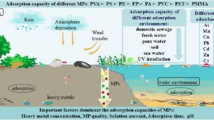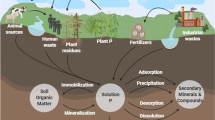Abstract
The production of nanoparticles (NPs) has increased significantly, given that they have numerous commercial and medical applications. There might have some risk associated with the release of these NPs in the environment. To assess the possible risk of releases of NPs in the groundwater, it is important to evaluate the fate and transport behaviour of NPs through porous media. The objective of this study is, therefore, to evaluate the transport behaviour of widely used NPs [i.e., silver (Ag), iron oxide (FexOy), titanium dioxide (TiO2) and zinc oxide (ZnO)] through porous media in the presence and/or absence of organic matter [i.e., humic acid (HA)] under controlled de-ionized and natural groundwater condition. To achieve the objective, first, the detailed characterizations of NPs are carried out in the presence and absence of HA. Column transport experiments were performed using a 1-D sand-packed column. Different NPs were injected from one end of the column with a flow rate of 0.0054 cm/sec. The result suggests that nAg, nTiO2, and nZnO particles are colloidal stable in the suspension, while nFexOy particles tend to aggregate and settle down very rapidly. However, in the presence of HA, the colloidal stability of nFexOy in the suspension increases significantly. Evaluation of transport behaviour of different metal NPs suggests that a high amount of nFexOy (C/C0=0.01) and nZnO (C/C0=0.09) particles are retained in the porous media. However, in the presence of HA, the transport efficiency of nFexOy (C/C0=0.64) increases significantly. The extensively high amount of nAg and nTiO2 particles are transported in the absence/presence of HA. The surface charge of particles and thus the interaction energy between the NPs and the sand is the main factor controlling the deposition of NPs. Overall, it could be stated that there is a risk of migration of nAg and nTiO2 particles irrespective of the presence of organic matter or of nFexOy particles in the presence of organic matter through the aquifer porous media. However, in the natural groundwater system, when the different ion is present, the extent of transport of NPs is expected to be less, and the risk associated with releasing of NPs in the groundwater would be comparatively low than that is predicted under the controlled de-ionized water condition. However, the nTiO2 particles always have a high risk of release into the groundwater.







Similar content being viewed by others
References
Chowdhury I, Hong Y, Honda R J and Walker S L 2011 Mechanisms of TiO2 nanoparticles transport in porous media: Role of solution chemistry, nanoparticles concentration, and flowrate; J. Colloid Interface Sci. 360 548–555.
Chen G, Liu X and Su C 2012 Distinct effects of humic acid on transport and retention of TiO2 rutile nanoparticles in saturated sand columns; Environ. Sci. Technol. 46(13) 7142–7150.
Dibyanshu and Raychoudhury T 2019 Co-transport behaviour of nano-ZnO particles in the presence of metal-nanoparticles through saturated porous media; J. Environ. Chem. Eng. 7(3) 103103.
Fang J, Shan X Q, Wen B, Lin J M and Owens G 2009 Stability of titania nanoparticles in soil suspensions and transport in saturated homogeneous soil columns; Environ. Pollut. 157(4) 1101–1109.
Fazeli Sangani M, Owens G and Fotovat A 2018 Transport of engineered nanoparticles in soils and aquifers; Environ. Rev. 999 1–28.
Jiang X, Tong M, Lu R and Kim H 2012 Transport and deposition of ZnO nanoparticles in saturated porous media; Colloids and Surfaces A: Physicochem. Eng. Asp. 401 29–37.
Jones E H and Su C 2014 Transport and retention of zinc oxide nanoparticles in porous media: Effects of natural organic matter versus natural organic ligands at circumneutral pH; J. Hazard Mater. 275 79–88.
Kanel S R and Al-Abed S R 2011 Influence of pH on the transport of nanoscale zinc oxide in saturated porous media; J. Nanoparticle Res. 13(9) 4035–4047.
Khan I, Saeed K and Khan I 2017 Nanoparticles: Properties, applications and toxicities; Arab. J. Chem. 12(7) 908–931, ISSN: 1878-5352.
Kumar A, Dibyanshu and Raychoudhury T 2020 Long-term fate of ZnO-FexOy mix nanoparticles through the saturated porous media under constant head condition; Sci. Total Environ. 721 137669, https://doi.org/10.1016/j.scitotenv.2020.137669.
Lanphere J D, Rogers B, Luth C, Bolster C H and Walker S L 2014 Stability and transport of graphene oxide nanoparticles in groundwater and surface water; Environ. Eng. Sci. 31(7) 350–359.
Li Y, Wang Y, Pennell K D and Abriola L M 2008 Investigation of the transport and deposition of fullerene (C60) nanoparticles in quartz sands under varying flow conditions; Environ. Sci. Technol. 42(19) 7174–7180.
Mahdi K N, Peters R, van der Ploeg M, Ritsema C and Geissen V 2018 Tracking the Transport of Silver Nanoparticles in Soil: A Saturated Column Experiment. Water Air Soil Pollut. 229(10) 334.
Nowack B and Bucheli T D 2007 Occurrence, behavior and effects of nanoparticles in the environment; Environ. Pollut. 150(1) 5–22.
Phenrat T, Saleh N, Sirk K, Tilton R D and Lowry G V 2007 Aggregation and sedimentation of aqueous nanoscale zerovalent iron dispersions; Environ. Sci. Technol. 41(1) 284–290.
Raychoudhury T, Naja G and Ghoshal S 2010 Assessment of transport of two polyelectrolyte-stabilized zero-valent iron nanoparticles in porous media; J. Cont. Hydrol. 118 143–151.
Raychoudhury T and Surasani V K 2017 Implication of surface modified NZVI particle retention in the porous media: Assessment with the help of 1-D transport model; J. Earth Syst. Sci. 126(4) 56.
Raychoudhury T, Tufenkji N and Ghoshal S 2012 Aggregation and deposition kinetics of carboxymethyl cellulose-modified zero-valent iron nanoparticles in porous media; Water Res. 46(6) 1735–1744.
Raychoudhury T, Tefenkji N and Ghoshal S 2014 Straining of polyelectrolyte-stabilized nanoscale zero-valent iron particles during transport through granular porous media; Water Res. 50 80–89.
Sagee O, Dror I and Berkowitz B 2012 Transport of silver nanoparticles (AgNPs) in soil; Chemosphere 88(5) 670–675.
Tangaa S R, Selck H, Winther-Nielsen M and Khan F R 2016 Trophic transfer of metal-based nanoparticles in aquatic environments: A review and recommendations for future research focus; Environ. Sci. Nano. 3 966–981.
Thio B J R, Zhou D and Keller A A 2011 Influence of natural organic matter on the aggregation deposition of titanium dioxide nanoparticles; J. Hazard Mater. 189 556–563.
Wang Y, Gao B, Morales V L, Tian Y, Wu L, Gao J, Bai W and Yang L 2012 Transport of titanium dioxide nanoparticles in saturated porous media under various solution chemistry conditions; J. Nanoparticle Res. 14(9) 1095.
Wang D, Shen C, Jin Y, Su C, Chu L and Zhou D 2017 Role of solution chemistry in the retention and release of graphene oxide nanomaterials in uncoated and iron oxide-coated sand; Sci. Total Environ. 579 776–785.
Wiesner M R, Lowry G V, Alvarez P, Dionysiou D and Biswas P 2006 Assessing the risks of manufactured nanomaterials; Environ. Sci. Technol. 40(14) 4336–4345.
Yao K M, Habibian M T and O’Melia C R 1971 Water and waste water filtration: concepts and applications; Environ. Sci. Technol. 5(11) 1105–1112.
Zhang M, He F, Zhao D and Hao X 2017 Transport of stabilized iron nanoparticles in porous media: Effects of surface and solution chemistry and role of adsorption; J. Hazard. Mater. 322 284–291.
Acknowledgements
We would like to acknowledge SERB-DST for funding the project under the Young Scientist Start-up Scheme (Project no. YSS/2015/000983). We would also like to thank Mr. Pranjay Joshi, the junior research fellow at IIT Patna, for helping with few analyses.
Author information
Authors and Affiliations
Corresponding author
Additional information
Communicated by Abhijit Mukherjee
Corresponding editor: Abhijit Mukherjee
Supplementary materials pertaining to this article are available on the Journal of Earth Science Website (http://www.ias.ac.in/Journals/Journal_of_Earth_System_Science).
Electronic supplementary material
Below is the link to the electronic supplementary material.
Rights and permissions
About this article
Cite this article
Dibyanshu, Raychoudhury, T. Transport behaviour of different metal-based nanoparticles through natural sediment in the presence of humic acid and under the groundwater condition. J Earth Syst Sci 129, 145 (2020). https://doi.org/10.1007/s12040-020-01411-2
Received:
Revised:
Accepted:
Published:
DOI: https://doi.org/10.1007/s12040-020-01411-2




